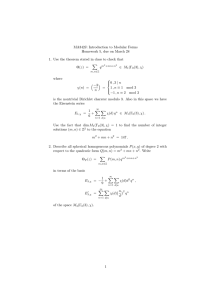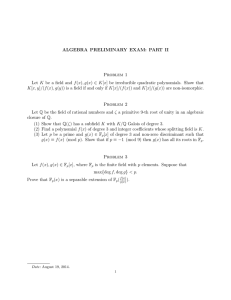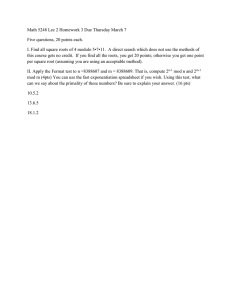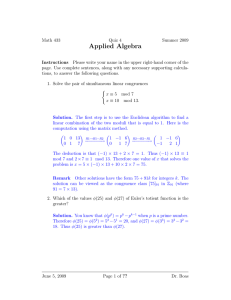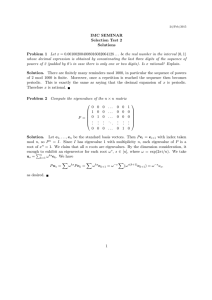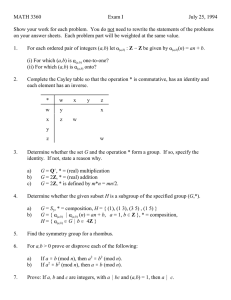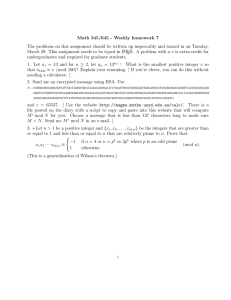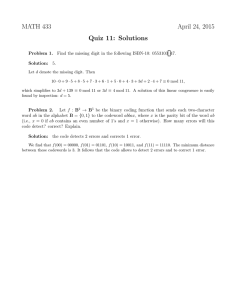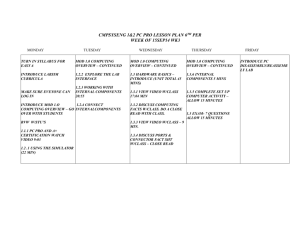(1.3) v`>> = zrW""r> - American Mathematical Society
advertisement
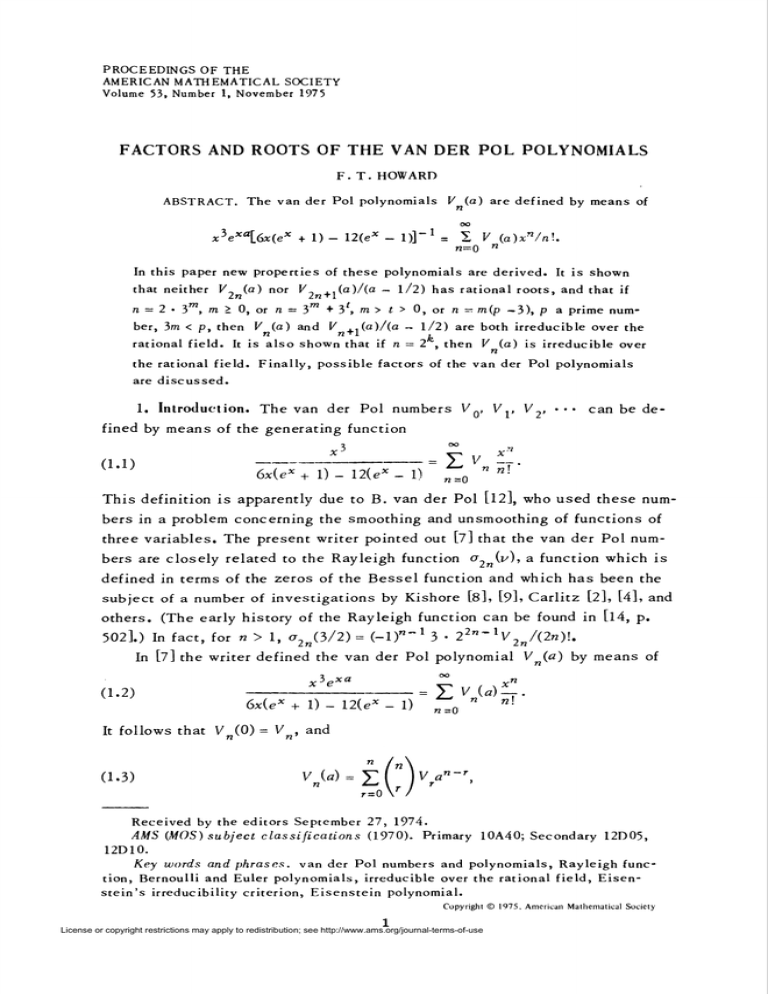
PROCEEDINGS OF THE
AMERICAN MATHEMATICAL SOCIETY
Volume 53, Number 1, November 1975
FACTORS AND ROOTS OF THE VAN DER POL POLYNOMIALS
F. T. HOWARD
ABSTRACT.
The van der Pol polynomials
V (a) are defined
by means
of
oo
xlexa\jox(ex
+ 1) - 12(e* - l)]-1
= 1
V (a)xrt/n\.
n=0
In this
that
paper
new properties
neither
V', (a)
nor
K,
of these
polynomials
,,(a)/(a
~ 1/2)
"
are derived.
has
rational
n = 2 • 3™, m > 0, or n = 3m + 3 , m > t > 0, or n - m(p -3),
ber,
3m < p, then
rational
the
field.
rational
V (a)
It is also
field.
and
V
,,(a)/(a
shown
Finally,
that
-
1/2)
are both
if n = 2 , then
possible
factors
n
van
and that
p a prime
irreducible
V (a)
of the
It is shown
roots,
if
num-
over
is irreducible
der
Pol
the
over
polynomials
are discussed.
la Introduction.
fined
by means
The van
der
of the generating
Pol
numbers
V , V.,
can be de-
function
2
U ;
V2> •••
OO
6x{e*+ 1) - 12U* - 1) Zo "nl
This
definition
is apparently
bers
in a problem
three
variables.
bers
are closely
due to B. van der Pol [l2j,
concerning
The
present
related
defined
in terms
subject
of a number
others.
(The
early
the smoothing
and unsmoothing
writer
out [7J that
of investigations
history
(1.2)
defined
a
= (.-If"1
of functions
of
which
has
[S>L Carlitz
can be found
been
is
the
[2], [4], and
in [l4,
p.
5 • 2ln~lV 2n/(2n)\.
the van der Pol polynomial
1)-
num-
the van der Pol num-
and which
fe],
function
these
(v), a function
function
by Kishore
of the Rayleigh
-—-=£v(*)*
6x(ex+
function
of the Bessel
502].) In fact, for « > 1, ^(3/2)
In [7] the writer
pointed
to the Rayleigh
of the zeros
who used
12(e*-l)
„=Q "
V (a) by means
of
"!
It follows that Vn (0) = Vn , and
(1.3)
v'>>=zrW""r>
Received by the editors September
AMS (MOS) subject classifications
27, 1974.
(1970).
Primary 10A40; Secondary
12D05,
12D10.
Key words and phrases,
van der Pol numbers
and polynomials,
tion, Bernoulli
and Euler polynomials,
irreducible
over the rational
stein's
irreducibility
criterion,
Eisenstein
polynomial.
Rayleigh
funcfield,
Eisen-
Copyright © 1975. American Mathematical
1
License or copyright restrictions may apply to redistribution; see http://www.ams.org/journal-terms-of-use
Society
2
F.T.HOWARD
(1.4)
V ia) = (-l)nV
n
In [6] it was proved
0 and
1, and
0 and
1„ It was
that
x = 0, x = x/i, and
shown
that
der Pol polynomials
have
Bernoulli
and Euler
polynomials.
example.
The first
al factors
(a)
properties
• • • + c,a
then
(e)
to those
n
V (a)/(a
- XA)has
c Q, . . . , c
for
in V5.
of the roots
we prove
and ration-
the following:
roots.
no rational
are integers,
c , . . ., c,
2], and [ll],
are listed
- l/2) has
~ ^
that the van
of the well-known
In particular
V 2n+l(a)/(a
on the lines
[10, Chapter
no rational
between
roots.
a factor
of the form
c
+
k > 0, c, / 0 (mod 5).
^as a factor
are integers,
of the form cQ + c^a +
then
if c_ ^ 0 (mod 5), we
c. = 0 (mod 5) for all i > 0.
ff n = 2 • 3m, m > 0, or n = 3m + 3', m > t > 0, or n = m(p - 3) where
p is a prime
and
3m < p, then
over the rational
Preliminaries.
terms,
we examine
&
lemma.
the lemma
for
V +,(a)/(«
V (a) is irreducible
The van der Pol numbers
of 2, 3, and 5 dividing
lowest
V (a) and
- Vi) are irreducible
field.
(f) If n = 2 , & > 0, then
following
it appears
\i\,
roots
a = M, between
Thus
our investigation
V (a) has
or ^2n+l(fl^fl
, k > 0, where
must have
when
[l],
including
roots
we continue
where
(d) If V2n(a)
roots,
van der Pol polynomials
V2 (a) nor
c .a + • • •+ c,ak
its
similar
See
two real
no nonreal
plane.
of the van der Pol polynomials.
(c) Neither
powers
real
eight
If n is even
'
exactly
paper
(b) If n is odd then
2.
three
V n (a) has
x = 1 in the complex
In the present
(1 - a).
for n > 0, V 2 (a) has
V2 + {(a) nas exactly
also
n
[6], Ui.
the roots
and factors
Since
2V, In
V.,In . Similar
are rational
the denominator
are known
over the rational
and the exact
of V , when
Because
this
V
information
+ l)V
congruences
b
is reduced
will
of V (a), we incorporate
., = -(in+1
field.
it into
the
for n > 1 [7], we shall
In
obviously ' hold
for
to
be useful
state
V,,2n +.,.l
Lemma 2.1. (a) // n > 1 then 2V2n = 1 (mod 4).
(b) If n> 1 then for b = 0, 1, 2, 3V2n = & (mod 3) «'/ 2n = b + 1 (mod 3).
(c)
// n > 0 //>en 5"V2n/(2«)!
(d) // p is a prime,
= 3" (mod 5).
p > 3, /Ack /or k > 0, pnVn(
3)/[n(p
- 3)]! = (-12)"
(mod p).
When proving
of Eisenstein's
Lemma
2.2.
coefficients
p) for all
irreducibility
theorems,
we shall
use
the following
version
criterion.
If f(x) - c
and if there
i > 0, c
^0
+ c.x
is a prime
+ • • •+c
p such
(mod p ), then
f(x)
x"
that
is a polynomial
c.
with
integer
^ 0 (mod p), c. = 0 (mod
is irreducible
over
the rational
field.
Suppose
f(x)
is a polynomial
with
rational
coefficients.
License or copyright restrictions may apply to redistribution; see http://www.ams.org/journal-terms-of-use
If there
is an
FACTORS AND ROOTS OF VAN DER POL POLYNOMIALS
integer
ses
h such
that
of Lemma
ly an Eisenstein
Lemma
hf(x)
2.2, then
2.3.
coefficients
// f(x) = c.
+ c x -t-• • • + c x"
Proof,
is a prime
if f(u/b)
and satisfies
f{x) an Eisenstein
is irreducible
i > 0, then
we must have
coefficients
call
polynomial
and if there
p) for all
has integer
we shall
ft is easy
= 0 where
u and
b are integers,
to see that if f(x)
satisfies
the above
induction
integer.
number
reduced
on i, we can show that each
the denominator
Assume
an integer,
r,
(u, b) = 1,
paper
of p dividing
2.4.
Let
hypotheses,
then
r. is integral
for
we use the notation
Now,
(mod p); that
using
is, p does
cn = br.
0
at f(x)
is an
0
, - ur^, and since
looking
p
terms.
i = 0 since
c, = br,
(mod p). Now,
)
lowest
c. (mod p), which is impossible
this
n > 3 with nonzero
to its
This is true
I
must be integral
Throughout
Lemma
of r..
true for i = k — 1; then
that bx - u divides
est power
integer
b £ 0 (mod p). We can write
r. is a rational
not divide
with
c„ ^ 0 (mod p), c. = 0 (mod
f(x) = (bx - u)(r0 + r,x + • • • + rn_ xxn~
each
field.
is a polynomial
that
Clear-
b = 0 (mod p).
u £ 0 (mod p). Now suppose
where
the hypothe-
polynomial.
over the rational
p such
3
c,
is
(mod p), we see
(see [l3, pp. 74—77]).
h tI
\ \ c to mean
p
h
is the high-
c.
f(x) -c+c.x+.-.+
integer
c x"
coefficients.
Suppose
be a polynomial
f(x)
has
of degree
all the following
properties:
(a) There
is a prime
p such
that
cQ £ 0 (mod p), c{ = 0 (mod p) for all
i > 0.
(b)
// pki ||ii c i'., i > 0, then kn —i,>k
"■ ' > r
—
,, k.i >
k.., - 1,' k.i —
> k..,
- 1.
— i +l
i+2
n—2
(c) f(a) = 0 implies /(l - a) = 0.
T^ew we can conclude
that
f(x)
has no rational
roots.
Proof. We know from Lemma 2.3 that if f(u/b) = 0, then b = 0 (mod p).
By hypothesis
(c) we can write
f(x) = (bx - u)(bx - b + u)(r0 + r. + • • • + r _ 2xn~2)
where
each
r. is a rational
i
number
reduced
to its lowest
terms.
Since
c i. = u(b - u)r.i - b r.i-l , + b r.i-2 .,,
we can prove
show that
since
if p
|| c., then
cQ = u(b - "Vn.
u(b - u\.
p
by induction
on i that each
p
- b r{_x + b r._2>
|| numerator
of r..
|| numerator
Suppose
r. is integral
of r..
This
(mod p). Now we
is true for i = 0
it is true for all /' < z'. Then
and by part (b) of our hypotheses
Now since
License or copyright restrictions may apply to redistribution; see http://www.ams.org/journal-terms-of-use
we have
c. =
we must have
4
F.T.HOWARD
c
T = b2r
n-i.
we have
A-b2r
n-4
n—i
a contradiction
We shall
make
, + u(b - u)r
n-2
of hypothesis
use
,
and
(b).
of the well-known
c
n-1
, = b2r
Therefore
facts
, - b2r
n- 3
f(u/b)
n-2'
,,
£ 0.
in the following
lemma
[5,
pp. 263, 271].
Lemma 2.5.
// p is a prime and
m = aQ + a xp + ■• ■ + ajin
r=bQ
(0 < a. < p),
+ b1p + --- + bnpn
(0<b.<p),
then
O'w(n)-C) <-°dw(b) // pk || m\ then k = (m - a
3. Rational
Lemma
rational
2.4,
roots
we shall
and factors
prove
that
- a^-«„)/(?
- l).
of the van der Pol polynomials.
neither
V2 (a) nor
V'
+l(a)/(a
By using
- Vi) has
roots.
Theorem 3.1. For n > 0,
5nV2nia)/i2n)\
5nV2n+1(a)/(2n+
Proof.
= 3"
(mod 5),
1)!= 3"_1 + 3" • a
(mod 5).
By (1.3) we have
5"V,
(a)
2n
(2n)!
» 5rV,
,„_,
= y_2z_L_fl
(2r)! ' (2« - 2r)l
r=0
2" -2r
(3-D
y
2r + 1 .
^
(2r+ 1)! ' (2b-
■>_fl2n-2r-l
2r-
1)!
Now by Lemma 2.5(b) we see that if 5k \\ (2b - 2r)l or 5k || (2b - 2r - 1)!,
then
k < n - r except
for the case
r - n.
Thus
by Lemma
5nV, (a)/(2n)! = 5nV, /(2b)! = 3"
472
The proof is similar
Corollary.
Zn
for V,
then
V (a)/(a
we have
(mod 5).
+\(a)'
For n > 0,
5"V2n + 1(a)/(2B + l)!(a - V) = 3"
Theorem
2.1(c)
3.2.
// n is even
— Vi) has
then
no rational
V (a) has
(mod 5).
no rational
roots.
License or copyright restrictions may apply to redistribution; see http://www.ams.org/journal-terms-of-use
roots.
If n is odd
FACTORS AND ROOTS OF VAN DER POL POLYNOMIALS
Proof.
of Lemma
by the
When
corollary
V {a)/(a
3.3.
j (a) =c-
by Theorem
3.1 that
no rational
roots.
3.1 and by Lemma
all the hypotheses
If n is odd,
2.3 that
if u/b
b = 0 (mod 5). We can now proceed
2.4 to show
Theorem
we see
V (a) has
to Theorem
- Vi), then
of Lemma
form
n is even,
2.4 are met and
that
V (a)/(a
// either
+ c.«+•••+
where
is a root
of
roots.
- Vi) has
c., . . . , c,
we see
as we did in the proof
- Vi) has no rational
V2 (a) or V2 +1(a)/(«
c ,a
5
a factor
are integers,
of the
k > 0, c. ^
0 (mod 5), then c. = 0 (mod 5) for all i > 0.
Proof.
Suppose
5) for some
V 2 (a) does
m > 0. Then
have
such
a factor
f(a)
where
c
£ 0 (mod
we can write
(3.2)
5nV2n(a)/(2n)\
= f(a) ■ g(a)
where
(3.3)
each
5nV2
g(a) = rQ + r:a+
r.i a rational
number
(a)/(2n)l
is integral
reduced
• • ■ + r2n_ka2n~k,
to lowest
terms.
(mod 5), and since
Since
each
the coefficient
coefficient
of a'
r i.c 0 + r.i— ,c,
on i to rprove
l I +• • • + rnc
0 z'., we can use induction
(mod 5). Thus by Theorem 3-1 we see that f(a) divides
that
tegral
contradiction.
The proof for
Theorem
form
3.4.
f(a) =c»
Neither
+ c.«+•••+
V'
V,
in
+.(a)/(a
(a) nor
c, a
of
in (3.2) is
r.! is in-
1 (mod 5), a
— lA) is similar.
V,
2nTi
where
.,(a)/(a
- ]/2) has
c ., . . . , c,
a factor
are integers,
of the
k > 0, c,
^
0 (mod 5).
Proof.
Suppose
V2 (a) does
write (3.2) and (3.3).
we can use
induction
Thus
by Theorem
3.1 we see
criterion
and Euler
method
f{a)
/(«).
of <z
on i to prove
that
a factor
that
again
we can
in (3.2) is ci/i + Ck-1T' 1
r.
divides
Then
,_
is integral
(mod 5).
1 (mod 5), a contradiction.
+1(a)/(fl - Vi) is similar.
4. Some cases
ibility
such
Since the coefficient
+ ...
The proof for V.
have
of irreducibility.
to obtain
polynomials.
results
Carlitz
concerning
[3] used
With the aid of Lemma
on the van der Pol polynomials.
Eisenstein's
the irreducibility
2.1, we shall
It is perhaps
irreduc-
of the Bernoulli
use
useful
the same
to recall
that
Vn (a) is monic.
Theorem
V (a) and
4.1.
Let
V +,(a)/(a
n = m(p - 3) where
— Vi) are irreducible
p is a prime
over
and
the rational
field.
Proof. We have
" /(m - Dp + p - 3m\
pV„{a) = p'£
(
\
)Vra
License or copyright restrictions may apply to redistribution; see http://www.ams.org/journal-terms-of-use
3m < p. Then
•
6
F.T.HOWARD
In 17J it is proved
that
[p, 2(p - 3)),...
if r is in any of the half open
. Vim- l)p, mip - 3)), then
p2Vr = 0
Thus
by Lemma
(mod p),
2.5 (a) and Lemma
V (a) is an Eisenstein
show
that
V +,(a)/(«
Vf is integral
[0, p — 3),
(mod p). Also
0 <r <m(p - 3).
2.1 (d) we have
pVn(a) ~ pVn 4 0
Thus
intervals
polynomial,
- Vi) is an Eisenstein
(mod p).
and in a similar
way we can
polynomial.
In that
case
also
we
first prove that
pmVn + l(a)/(n+
l)! = «(-12)m
+ 6(-12)m-1
(mod p),
so
pmVn+1(a)A(n+
and the theorem
l)\ia-V2)]^(-n)m
(mod p),
follows.
Theorem 4.2. // n = 3m + 3', m > t > 0, or if n = 2 • 3m, m > 0, then
V (a) and
Proof.
V
.,(a)/(a
Let
— Vi) are irreducible
over
the rational
n = 3m + 3' or n - 2 • 3m■ In either
case,
field.
by Lemma
2.5 (a)
and Lemma 2.1 (b) we have
3V (a) = 3 Y ( n V an~r = 3V =2
Thus
V (a) is an Eisenstein
polynomial.
3Vn+1 Aa) = 2a+2
and so
3V +,(a)/(a
Theorem
4.4.
(mod 3),
(mod 3).
Also
3Vrc +iAa)/(a - }/2)= 2 (mod 3)
— Vi) is an Eisenstein
polynomial.
If n = 2 , & > 0, «/>eB V (a)
z's irreducible
over
the
ration-
al field.
Proof.
By Lemma
2.5 (a) and Lemma
2.1 (a) we have
n (2k\
2Vnia) = 2 £
I
1 Van~T = 2Vn = 1 (mod 2),
r=0
since
/2A
l
We can now see
that
1= 0
V (a)
(mod 4)
is an Eisenstein
if r is odd.
polynomial
and the theorem
fol-
lows.
If we examine
V (a)
rc
for
0 < b < 100, the theorems
—
—
License or copyright restrictions may apply to redistribution; see http://www.ams.org/journal-terms-of-use
of this
section
tell
FACTORS AND ROOTS OF VAN DER POL POLYNOMIALS
7
us that if n is even, n 4-.22, 46, 62, 66, 72, 74, 82, 92, 98, then Vn(a) is
irreducible
over the rational
field.
Also, if n is odd, n ^ 23, 47, 63, 67, 73,
75, 83, 93, 99, then V (a)/(a - Vi) is irreducible
over the rational
field.
5. The first 8 van der Pol polynomials.
V0(a)=l,
V,(a) = a--,
2
V 2Xa) = a - a -i—,
5
w
( \ = a-a3
K,(a)
3 2 +-a-,
3
3
2
1
5
20
V 4,(a) = a4 - 2a3 + -a2-a-,
5
5
,, / \
5
5 4
y Afl) = fl-a
5
2
.. 3
+ 2a ^-a-a
350'
1 2
1
2
70
,jv Xa)
l \ = a 6 - 3a
? 5 + 3a
-, 4 -a-a 3
6
,/f\
77^21574+—a-a-a
V Xa)
= a-a
'
2
5
+-,
32
1
140
3
1
+ —a
70 h-, 1050
70
I3
4
32
+—an-a-.
20
10
1
1
150
300
REFERENCES
1. J- Brillhart,
On the Euler
and
Bernoulli
polynomials,
J. Reine
Angew.
Math.
234 (1969), 45-64. MR 39 #4117.
2.
L. Carlitz,
A sequence
of integers
related
to the Bessel
functions,
Proc.
Amer. Math. Soc. 14 (1963), 1-9. MR 29 #3425.
3.-,
Note
on irreducibility
Math. J. 19 (1952), 475-481.
4.-,
Recurrences
of the Bernoulli
and Euler
polynomials,
Duke
MR 14, 163.
for the Rayleigh
functions,
Duke Math. J. 34 (1967),
581-590. MR 35 #5670.
5. L. E. Dickson,
History
of the theory of numbers.
Carnegie
Institution
of Washington,
Washington,
D. C,
6. F. T. Howard,
Properties
Vol.
1919.
of the van der Pol numbers
1, Publication
no. 256,
and polynomials,
J.
Reine Angew. Math. 260 (1973), 35-46. MR 47 #6603.
7.-,
The van der Pol numbers
and a related
sequence
of rational
numbers,
Math. Nachr. 42 (1969), 89-102. MR 41 #3385.
8. N. Kishore, The Rayleigh function,
Proc. Amer. Math. Soc. 14 (1963), 527-
533. MR 27 # 1633.
9. -,
The Rayleigh
polynomial,
Proc. Amer. Math. Soc. 15 (1964), 911-
917. MR 29 #6079.
10.
N. E. Norlund,
Vorlesungen
uber
Differenzrechnung,
Springer-Verlag,
Berlin,
1924.
11.
R. Spira,
The nonvanishing
of the Bernoulli
polynomials
Proc. Amer. Math. Soc. 17 (1966), 1466-1467. MR 34 #2967.
License or copyright restrictions may apply to redistribution; see http://www.ams.org/journal-terms-of-use
in the
critical
strip,
8
ics
F. T. HOWARD
12. B. van
in Physical
13.
der
Pol. Smoothing
and
Sciences,
Interscience,
B. van der Waerden,
Modern
"unsmoothing",
New
algebra,
York,
Probability
1957,
Springer,
pp.
Berlin,
and
223—235-
1937;
Relate
Top-
English
transl.,
2nd ed.,
Cam-
Ungar, New York, 1949. MR 10, 587.
14. G. N. Watson,
bridge Univ. Press,
A treatise
Cambridge;
on the theory
Macmillan,
of Bcssel
functions,
New York, 1944. MR 6, 64.
DEPARTMENT OF MATHEMATICS, WAKE FOREST UNIVERSITY, WINSTON-SALEM,
NORTH CAROLINA 27109
License or copyright restrictions may apply to redistribution; see http://www.ams.org/journal-terms-of-use
